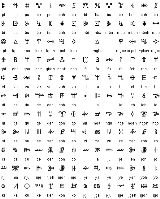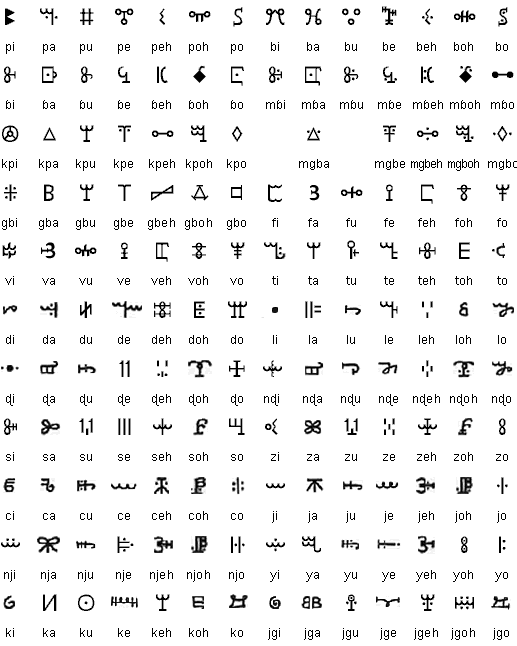
Vai script
Encyclopedia

Syllabary
A syllabary is a set of written symbols that represent syllables, which make up words. In a syllabary, there is no systematic similarity between the symbols which represent syllables with the same consonant or vowel...
devised for the Vai language
Vai language
The Vai language, alternately called Vy or Gallinas, is a Mande language, spoken by roughly 104,000 in Liberia and by smaller populations, some 15,500, in Sierra Leone. It is noteworthy for being one of the few sub-Saharan African languages to have a writing system that is not based on the Latin...
by Momolu Duwalu Bukele of Jondu, in what is now Grand Cape Mount County
Grand Cape Mount County
Grand Cape Mount is a county in the northwestern portion of the West African nation of Liberia. One of 15 counties that comprise the first-level of administrative division in the nation, it has five districts. Robertsport serves as the capital with the area of the county measuring...
, Liberia
Liberia
Liberia , officially the Republic of Liberia, is a country in West Africa. It is bordered by Sierra Leone on the west, Guinea on the north and Côte d'Ivoire on the east. Liberia's coastline is composed of mostly mangrove forests while the more sparsely populated inland consists of forests that open...
. He is regarded within the Vai
Vai (ethnic group)
The Vai are a Manden ethnic group that live mostly in Liberia and small minority live in south-eastern Sierra Leone. The Vai are known for their indigenous syllabic writing system, developed in the 1820s by Duala Bukele and other tribal elders. Over the course of the 19th century, literacy in the...
community, as well as by most scholars, as the syllabary's inventor and chief promoter when it was first documented in the 1830s. It is one of the two most successful scripts in West Africa.
Possible link with Cherokee
In 1967 two scholars, working independently, suggested that the Cherokee syllabaryCherokee syllabary
The Cherokee syllabary is a syllabary invented by Sequoyah to write the Cherokee language in the late 1810s and early 1820s. His creation of the syllabary is particularly noteworthy in that he could not previously read any script. He first experimented with logograms, but his system later developed...
of 1819 provided a model for the design of the Vai syllabary (Tuchscherer 2002). One of them, P.E.H. Hair, suggested that the link was missionary groups working with both peoples. A different link was suggested by Svend Holsoe, who discovered a Cherokee (possibly half-Cherokee) man named Augustus or Austin Curtis who had settled in the Vai region at least four years before the invention of the script. He married into a prominent Vai family and became an important Vai chief himself. The "inscription on a house" that drew the world's attention to existence of the Vai syllabary was in fact on the home of Curtis. Both ideas have been mentioned by various authors since. In 2002 Tuchscherer and Hair, in a detailed analysis of the evidence (and noting that the evidence is only circumstantial), wrote:
What we can be reasonably sure about is that Curtis was not only a well-connected and influential man within the Vai community, but
one who spoke the Vai language and adopted Vai customs, who settled in Vai country some four years before the invention of the Vai script, and who later appears to have welcomed the use of the script on his house. If Curtis was informed about the Cherokee script, if he was already resident at Cape MountGrand Cape Mount CountyGrand Cape Mount is a county in the northwestern portion of the West African nation of Liberia. One of 15 counties that comprise the first-level of administrative division in the nation, it has five districts. Robertsport serves as the capital with the area of the county measuring...
by 1827/28, and if he made contact with any of the mission party at Big Town - Revey or even his Vai-speaking assistants - it is conceivable that the notion of a syllabary reached the Vai by this route - but perhaps not very likely. Finally, whether the argument from coincidence should have any weight is difficult to say, but that two new scripts sharing the same basic structure, invented a continent apart within little more than a decade of each other, can each be linked, however tenuously (given the limited evidence), to the same individual, may reasonably be regarded as at least singular.(Hair 2002)
Structure of the script
Vai is a simple syllabic script written from left to right that represents CV syllables; a final nasal is written with the same glyph as the Vai syllabic nasal. Originally there were separate glyphs for syllables ending in a nasal, such as don, with a long vowel, such as soo, with a diphthong, such as bai, as well as bili and sɛli. However, these have been dropped from the modern script.The syllabary did not distinguish all the syllables of the Vai language
Vai language
The Vai language, alternately called Vy or Gallinas, is a Mande language, spoken by roughly 104,000 in Liberia and by smaller populations, some 15,500, in Sierra Leone. It is noteworthy for being one of the few sub-Saharan African languages to have a writing system that is not based on the Latin...
until the 1960s when University of Liberia
University of Liberia
The University of Liberia is a publicly funded institution of higher learning located in Monrovia, Liberia. Authorized by the national government in 1851, the school opened in 1863 as Liberia College and became a university in 1951. The school is one of the oldest institutions of higher learning...
added distinctions by modifying certain glyphs with dots or extra strokes to cover all CV syllables in use. There are relatively few glyphs for nasal vowels because not only a few occur with each consonant.
Unicode
The Vai syllabary was added to the UnicodeUnicode
Unicode is a computing industry standard for the consistent encoding, representation and handling of text expressed in most of the world's writing systems...
Standard in April, 2008 with the release of version 5.1.
The Unicode block for Vai is U+A500–U+A63F. Grey areas indicate non-assigned code points:

